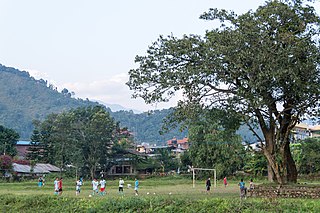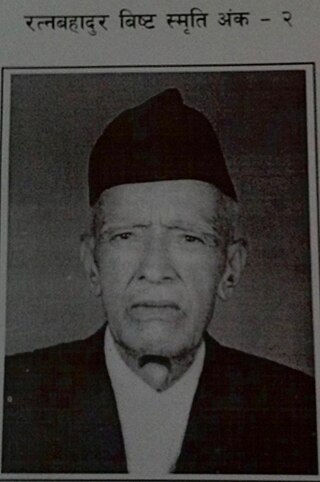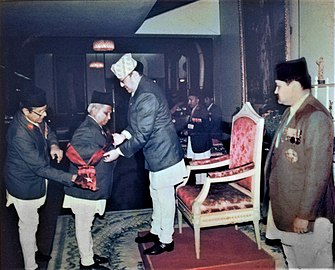
The Kingdom of Nepal,also known as the Gorkha Empire or Asal Hindustan (transl. Real Land of the Hindus),was a Hindu kingdom in South Asia,formed in 1768,by the unification of Nepal. Founded by King Prithvi Narayan Shah,a Gorkha monarch who claimed to be of Khas Thakuri origin,it existed for 240 years until the abolition of the Nepalese monarchy in 2008. During this period,Nepal was formally under the rule of the Shah dynasty,which exercised varying degrees of power during the kingdom's existence.

Birendra Bir Bikram Shah Dev was the tenth Shah Ruler and the King of Nepal from 1972 until his assassination in 2001. He was the eldest son of King Mahendra.

Gyanendra Shah is a former monarch who was the last King of Nepal,reigning from 2001 to 2008. As a child,he was briefly king from 1950 to 1951,when his grandfather,Tribhuvan,took political asylum in India with the rest of his family. His second reign began after the 2001 Nepalese royal massacre. Gyanendra Shah is the first person in the history of Nepal to be king twice and also the last king of the Shah dynasty of Nepal.

The Nepali Congress is a social democratic political party in Nepal and the largest party in the country. The party has 840,106 members as of the party's 14th general convention in December 2021 making them the second largest party by membership in Nepal.

The Nepalese royal massacre occurred on 1 June 2001 at the Narayanhiti Palace,the then-residence of the Nepalese monarchy. Nine members of the royal family,including King Birendra and Queen Aishwarya,were killed in a mass shooting during a gathering of the royal family at the palace. A government-appointed inquiry team named Crown Prince Dipendra as perpetrator of the massacre. Dipendra slipped into a coma after shooting himself.

Football is one of the major and the most popular sports of Nepal. It is governed by the All Nepal Football Association (ANFA). The present acting president of ANFA is Karma Kshiring Sherpa. The current top domestic league is the Martyr's Memorial A Division league. The Nepal national football team represents Nepal in all international competitions.

The Government of Nepal is the federal executive authority of Nepal. Prior to the abolition of the Nepali monarchy in 2006,it was officially known as His Majesty's Government.
Raja Rao Birender Singh was a King of erstwhile state of Haryana and an Indian politician. He served first as a minister in the state government of Punjab and then as Chief Minister of Haryana,and also served as a minister in Punjab state,Haryana state and the Union cabinet. He also served as the second speaker of Haryana state assembly in 1967. He coined an Indian political vocabulary Aya Ram,Gaya Ram to describe the practice of frequently floor-crossing by legislature.
Events from the year 2001 in Nepal.
Keshav Prasad Upadhyaya was a Nepalese judge who served as 13th Chief Justice of Nepal,in office from 16 December 1999 to 5 December 2002. He was appointed by the then-king of Nepal,Birendra.
Mohan Prasad Sharma was a Nepalese judge who served as 12th Chief Justice of Nepal,in office from 13 April 1998 to 15 December 1999. He was appointed by the then-king of Nepal,Birendra. Sharma was preceded by Om Bhakta Shrestha and succeeded by Keshav Prasad Upadhyaya. He died on 19 January 2022,at the age of 87.
Om Bhakta Shrestha was a Nepalese judge who served as 11th Chief Justice of Nepal,in office from 12 September 1997 to 12 April 1998. He was appointed by the then-king of Nepal,Birendra.
Trilok Pratap Rana (1933-2014) was a Nepalese judge who served as 10th Chief Justice of Nepal,in office from 15 February 1997 to 17 September 1997. He was appointed by the then-king of Nepal,Birendra.
Dhanendra Bahadur Singh was a Nepalese judge who served as 7th Chief Justice of Nepal,in office from 11 December 1985 to 7 August 1991. He was appointed by the then-king of Nepal,Birendra.
Nayan Bahadur Khatri was a Nepalese judge who served as 6th Chief Justice of Nepal,in office from 8 December 1976 to 10 December 1985. He was appointed by the then-king of Nepal,Birendra. He was the longest serving Chief Justice of Nepal.

Sir Ratna Bahadur Bista (1910–1990) was the fifth Chief Justice of Nepal. He was born in Dadeldhura to an aristocratic family that was given land grants in Sudurpashchim Province circa 1911 during a hunting trip by King George V of the United Kingdom and Chandra Shumsher Jang Bahadur Rana,the Prime Minister of the Rana Dynasty. He went on to become the 5th Chief Justice of Nepal,in office from 26 July 1970 to 6 August 1976. He was appointed by the then-king of Nepal,Mahendra. He was responsible for the Summary Procedure Act 1971. The Committee that he established recommended for the establishment of High Courts in different regions which resulted in the creation of a four tiered judicial structure with one additional tier in the middle- "the Regional Courts."

Bhagwati Prashad Singh was a Nepalese judge who served as 4th Chief Justice of Nepal,in office from 9 April 1964 to 10 July 1970. He was appointed by the then-king of Nepal,Mahendra.

Satchit Shamsher Jung Bahadur Rana was the 34th Chief of Army Staff of the Royal Nepalese Army. He was a member of the Rana Dynasty of Nepal.
Events from the year 1997 in Nepal.












